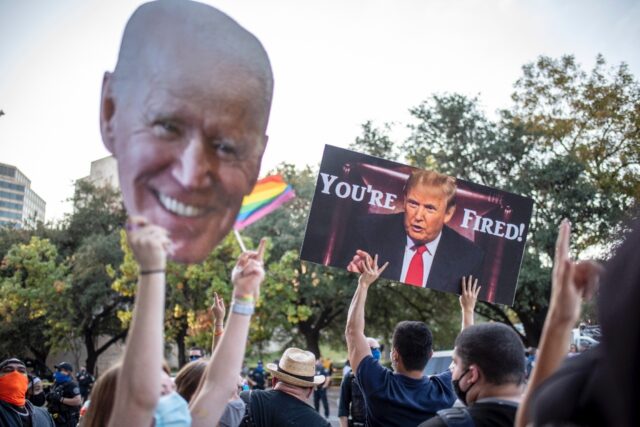The United States is a vibrant democracy of 330 million people, yet in an increasingly polarized nation the next president will likely be decided by just a few thousand votes, say analysts.
Landslide presidential elections were once common, but no candidate has won the popular vote by double figures since Ronald Reagan carried 49 of the 50 states against Walter Mondale in 1984.
Spool forward four decades and the race for the White House looks more like a crapshoot, with most states’ outcomes beyond doubt before a ballot has been cast and candidates duking it out for scant votes in just a few genuinely competitive states on Election Day.
“(It) strikes me that Nevada, Arizona, Wisconsin and Georgia will play particularly large roles in this election,” David Darmofal, vice chair of political science at the University of South Carolina, told AFP.
“So those suburban counties in Wisconsin, but also Milwaukee County, will be very important, as will Las Vegas suburbs and Clark County more generally, Maricopa County in Arizona, and Fulton County in Georgia as well as its surrounding counties such as Cobb and DeKalb.”
Where once you might have found conservatives voting Democratic and even the occasional liberal ticking the box for a Republican, the modern electorate is much more tribal, says Darmofal.
‘Less elastic’
“It’s more difficult today to get so far behind as the Democrats were in 1984, or for parties to quickly lose support with such an ideologically sorted and more engaged electorate,” he said.
“The electorate is less elastic in its preferences from election to election than it used to be.”
The historical record demonstrates Darmofal’s point.
A dozen 20th century elections were considered landslides yet the six since have typically been decided by fewer than 300,000 votes spread across an average of three states, according to campaign group National Popular Vote.
“Elections are closer because the two parties have learned to use social media and micro-targeting to mobilize organized groups of voters, and they have learned to vilify opponents,” said Jeremi Suri, a public affairs and history professor at the University of Texas at Austin.
“This creates a divided two-sided debate, and it makes it hard for either side to build a consensus.”
For Matt Shoemaker, a national security analyst and former intelligence officer, former president and current Republican frontrunner Donald Trump’s huge brand recognition in part explains voters becoming more entrenched over the last decade.
“Everyone knows who he is and has an opinion about him which will severely limit the number of swing votes or people on the fence, unsure of what they think of him or for whom to vote,” he told AFP.
Another close election
Seven states were decided by less than three points in 2020 — Arizona, which was the closest battleground, Georgia, Michigan, Nevada, North Carolina, Pennsylvania and Wisconsin.
Sabato’s Crystal Ball, an influential politics website produced at the University of Virginia, has identified the same four states as Darmofal as the “toss-up” states in the 2024 cycle.
Arizona — the biggest Sun Belt battleground, where a critical mass of suburban Phoenix voters often makes the difference — was decided by around 10,000 votes, and Georgia’s margin was under 12,000.
In Wisconsin — deep Trump country in the rural areas but Democrat-friendly in the Milwaukee suburbs — the margin has been less than a point in four of the last six elections.
Nevada has been more reliably Democratic, with Trump losing to Hillary Clinton and then Biden by 27,000 and 34,000 votes respectively, but in the Silver State things are tightening up.
Crystal Ball managing director Kyle Kondik wrote that the Democratic candidate — almost certainly Biden — will start 2024 closer to the 270 “electoral votes” required under the state-by-state Electoral College system than his Republican opponent.
“But with few truly competitive states and a relatively high floor for both parties,” he added, “our best guess is yet another close and competitive presidential election next year.”

COMMENTS
Please let us know if you're having issues with commenting.